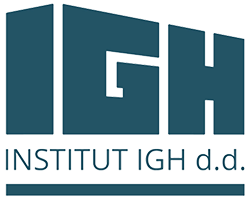
The A1 motorway is the longest motorway in Croatia, spanning 476.3 kilometers (296.0 mi). As it connects the nation's capital Zagreb to the second largest city Split, the motorway represents a major north–south transportation corridor in Croatia and a significant part of the Adriatic–Ionian motorway. Apart from Zagreb and Split, the A1 motorway runs near a number of major Croatian cities, provides access to several national parks or nature parks, world heritage sites, and numerous resorts, especially along the Adriatic Coast. National significance of the motorway is reflected through its positive economic impact on the cities and towns it connects as well as its importance to tourism in Croatia.
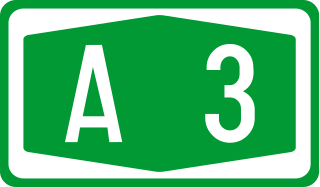
The A3 motorway is a major motorway in Croatia spanning 306.5 kilometres (190.5 mi). The motorway connects Zagreb, the nation's capital, to the Slavonia region and a number of cities along the Sava River. It represents a major east–west transportation corridor in Croatia and a significant part of the Pan-European Corridor X, serving as a transit route between the European Union states and the Balkans. Apart from Zagreb, where the A3 motorway comprises a considerable part of the Zagreb bypass, the motorway runs near a number of significant Croatian cities.

The A2 motorway is a motorway in the Hrvatsko Zagorje region of northern Croatia, connecting Zagreb to the Macelj border crossing and Slovenia. The A2 motorway is part of the European route E59 and the Pan-European Corridor Xa. The motorway spans 59.2 kilometres (36.8 mi) between the Slovenian border and the Jankomir interchange within the Zagreb bypass, providing road connections to a number of cities and towns besides Zagreb, including Krapina, Zabok and Zaprešić. All sections of the motorway, except the northernmost one between the Macelj border crossing and Trakošćan, and the southernmost one near Zagreb, are tolled, using a closed toll collection system.

The A4 motorway is a motorway in Croatia spanning 97.0 kilometres (60.3 mi). It connects the nation's capital, Zagreb, to the city of Varaždin and to Budapest, Hungary via the Goričan border crossing. The motorway represents a major north–south transportation corridor in Croatia and is a part of European routes E65 and E71. The A4 motorway route also follows Pan-European corridor Vb.

The A5 motorway is a motorway in Croatia spanning 59 kilometres (37 mi). It connects Osijek, the largest city in Slavonia region, to the Croatian motorway network at the Sredanci interchange of the A3 motorway. The A5 represents a significant north–south transportation corridor in Croatia and is a part of the European route E73. The A5 motorway route also follows Pan-European corridor Vc. In addition to Osijek, the A5 motorway also passes near Đakovo.

The A6 motorway is a motorway in Croatia spanning 80.2 kilometres (49.8 mi). It connects the nation's capital, Zagreb, via the A1, to the seaport of Rijeka. The motorway forms a major north–south transportation corridor in Croatia and is a part of European route E65 Nagykanizsa–Zagreb–Rijeka–Zadar–Split–Dubrovnik–Podgorica. The A6 motorway route also follows Pan-European corridor Vb.

The A7 motorway is a 42.4-kilometre-long (26.3 mi) motorway in Croatia. It connects the nation's largest port in Rijeka, to the Croatian motorway network, as well as to the Rupa and Pasjak border crossings to Slovenia. The motorway forms part of a longitudinal transportation corridor in Croatia, and it is a part of European route E61 Villach–Ljubljana–Trieste–Rijeka. The A7 motorway route south of Orehovica interchange, where it also intersects Pan-European corridor Vb, is a part of European route E65.

The A8 motorway is a 64.0-kilometre (39.8 mi) toll motorway in Croatia. It connects the A7 motorway near Rijeka with the road network in the Istrian peninsula via the Učka Tunnel. The road terminates at the Kanfanar interchange with the A9 motorway, which with the A8 motorway forms the Istrian Y road system. The motorway's national significance is reflected in its positive economic impact on the cities and towns it connects, as well as its importance to tourism in Croatia. The importance of the motorway for tourism is particularly high during the summer tourist season, when its traffic volume increases by about 65%.
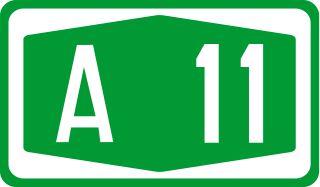
The A11 motorway is an incomplete motorway in Croatia, 30 kilometres long. It connects the Jakuševec interchange of the Zagreb bypass, to the south of Zagreb, to Velika Gorica and onwards to Sisak, but currently reaches only the Lekenik exit, as of the planned 42-kilometre (26 mi) route, 30 km (19 mi) are completed. The motorway is planned as a north–south transportation corridor for commuter traffic between the cities.
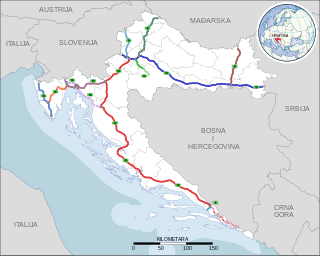
Highways in Croatia are the main transport network in Croatia. The Croatian classification includes several classes of highways:
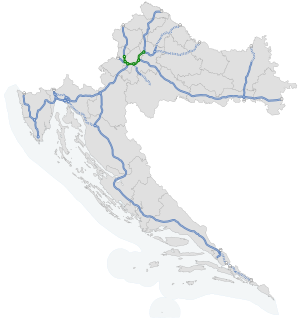
Zagreb bypass is a U-shaped motorway partially encircling Zagreb, Croatia. The largest part by far, between Jankomir and Ivanja Reka interchanges, was built between 1977 and 1979, while the Ivanja Reka – Sveta Helena section was built between 1996 and 1999. The bypass is 48.9 kilometres (30.4 mi) long, tracing around the city from the northwestern suburb of Zaprešić to Sveta Helena in the northeast. The bypass crosses the Sava River twice and comprises a bridge across the Sava-Odra floodwater overflow canal. As the busiest sections between Jankomir and Buzin interchanges carry traffic volume of approximately 45,000 AADT, it is the most heavily used motorway sector in Croatia.
Hrvatske ceste is a Croatian state-owned company pursuant to provisions of the Croatian Public Roads Act (Croatian: Zakon o javnim cestama enacted by the Parliament of the Republic of Croatia. The tasks of the company are defined by the Public Roads Act and its Founding Declaration, and the principal task of the company is management, construction and maintenance of public roads. In practice, Hrvatske ceste are responsible for the state roads in Croatia, while county and local roads are managed by county authorities and the motorways are managed by Hrvatske autoceste and other concessionaires.

Autocesta Rijeka – Zagreb was a Croatian state-owned joint-stock company founded pursuant to decision of the government of the Republic of Croatia of December 11, 1997, to facilitate construction and subsequent management of a motorway between Rijeka and Zagreb.
Viadukt is a Croatian civil engineering company, specialised in the areas of bridge, tunnel and road engineering. Other business activities of the company include construction and reconstruction of urban streets.

Čakovečki mlinovi is a Croatian milling company based in Čakovec. In addition to being the biggest producer of wheat flour in the country, it also produces baked goods and pumpkin seed oil. The company's shares are listed on the Zagreb Stock Exchange (ZSE) and is one of the 25 companies included in its official share index CROBEX as of September 2010.
Tehnika d.d. is a Croatian company, active in civil engineering and construction industry. Its primary activities include building construction, infrastructure and civil engineering works, architectural and engineering services, technical consulting, professional supervision services and real estate management. It is listed on the Zagreb Stock Exchange and is one of 25 companies included in the CROBEX share index. In 2010, net income of the company was 11.7 million kuna, exhibiting a decrease from 11.9 million kuna net income reported for 2009. According to 2010 annual report, the company employs 1281 persons.
Statuta Valachorum was a decree issued by Emperor Ferdinand II of the Habsburg monarchy on 5 October 1630 that defined the rights of "Vlachs" in the Military Frontier, in a way that it placed them under direct rule by Vienna, removing the jurisdiction of the Croatian parliament. This was one of three major laws enacted in the early 17th century on the taxation and tenancy rights of the Vlachs, together with the earlier 1608 decree by Emperor Rudolf II and a 1627 decree by Ferdinand.
Dalekovod d.d. is a Croatian company, active in electrical engineering and civil engineering sectors. Its primary activities comprise design, production and construction of electrical power structures, electrical substations, power transmission mains, telecommunications structures, road equipment, railway equipment and street lighting. In 2010, net income of the company was 4.7 million kuna, exhibiting a decrease from 110.9 million kuna net income reported for 2009. At the end of the 2010, the company employed 1424 persons. Dalekovod was founded in 1949 as a state owned company, and restructured as a joint stock company in 1993 and subsequently listed at the Zagreb Stock Exchange. It is one of 24 companies included in the CROBEX share index. As of August 2011, head of the company is Luka Miličić. Recently the company has declared its plans to expand in the energy development sector, especially in the field of renewable energy. In 2012, Dalekovod plans to invest into and build a wind farm near Benkovac and Obrovac.

The D10 expressway is a partially built expressway in the central Croatia northeast from Zagreb extending towards the city of Križevci. It is currently executed as a 35 km (14 mi) long expressway that spans from the A4 motorway Sveta Helena interchange via Vrbovec, to the city of Križevci. The D10 expressway represents the western arm of the so-called Podravina Y, as the eastern arm is planned to be the D12 expressway.
Jure Radić was a Croatian civil engineer and politician.
